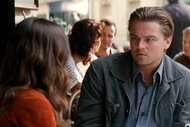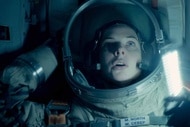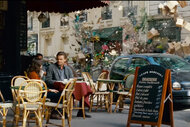Create a free profile to get unlimited access to exclusive videos, sweepstakes, and more!
'Have we become the monsters?': David Gordon Green reflects on Halloween Kills' deadly irony

When Halloween (2018) was first announced, audiences were understandably skeptical. Another reboot? Another long-gestated sequel — this one for arguably one of the most iconic and beloved horror movies of all time that already had nine follow-ups to its name. Writer/director David Gordon Green, and his co-writers Jeff Fradley and Danny McBride, proved up for the challenge though, and Halloween, a sequel that bypassed its predecessors to continue Laurie Strode's (Jamie Lee Curtis) story and explore the consequences of her showdown with Michael Myers all those years ago, was a hit both critically and at the box office.
For the follow-up, Halloween Kills — in theaters and available to stream on Peacock on Oct. 15 — the creative team went bigger. Whereas Halloween (2018) focused on Laurie and the generational trauma passed along to her daughter (Judy Greer) and granddaughter (Andi Matichak), Halloween Kills broadens the scope to question how the town of Haddonfield, Illinois, is collectively traumatized, still, 40 years after that fateful Halloween night. This results in an ensemble movie that brings back familiar characters and introduces a new generation of townies for Michael Myers to traumatize. It also permitted Green to get philosophical.
"If our first film was focusing on the fear that Michael Myers instilled on Laurie Strode and the legacy on generations of women, this is a study in how fear permeates a community," Green explained to SYFY. "And then by the end of the film, it's how that fear has transcended from just an anxiety of [a] serial killer per se to 'What has fear done to us, and have we become the monsters and where does evil begin and end?'"
Over the course of seven weeks, Green and his team shot night after night to accomplish this sequel to a sequel. "You're out of your mind a little bit making this movie, and you can see that reflected in the narrative and some of the performances and the way it's shot and edited," he muses. He admits to the film having a "dream-like quality," especially in one particular scene involving a mob. The actors — frenzied, screaming, running through hallways and up staircases — were encouraged to get to such a point that controlling the crowd proved impossible. "You can't even say 'cut,'" he adds. "It's just chaos."
The chaos was necessary, though, to exemplify just how much control fear has over Haddonfield. The movie is "an exploration of anxiety as much as it is the fear of the boogeyman," Green says, and that's undoubtedly a prescient topic in 2021.
"When we were slated to come out a year ago, we filmed it two years ago and we were like, 'This feels like it's of the time, this feels like a very relevant movie.' And now a year later it's like, 'Well this is even more relevant now,'" he says with a laugh. Most of the people in this film, he explains, are trying to confront their fear before they've even fully acknowledged what it is they're confronting. "It is strange in that way, but... something that [has always been] as scary to me as the monster under the bed is all of the people who are afraid of the monster under the bed uniting to go get the monster," he adds. "'Where does it begin and end?' is the question of the film."
SYFY, Universal Pictures, and Peacock are properties of NBCUniversal, a subsidiary of Comcast Corporation.

























